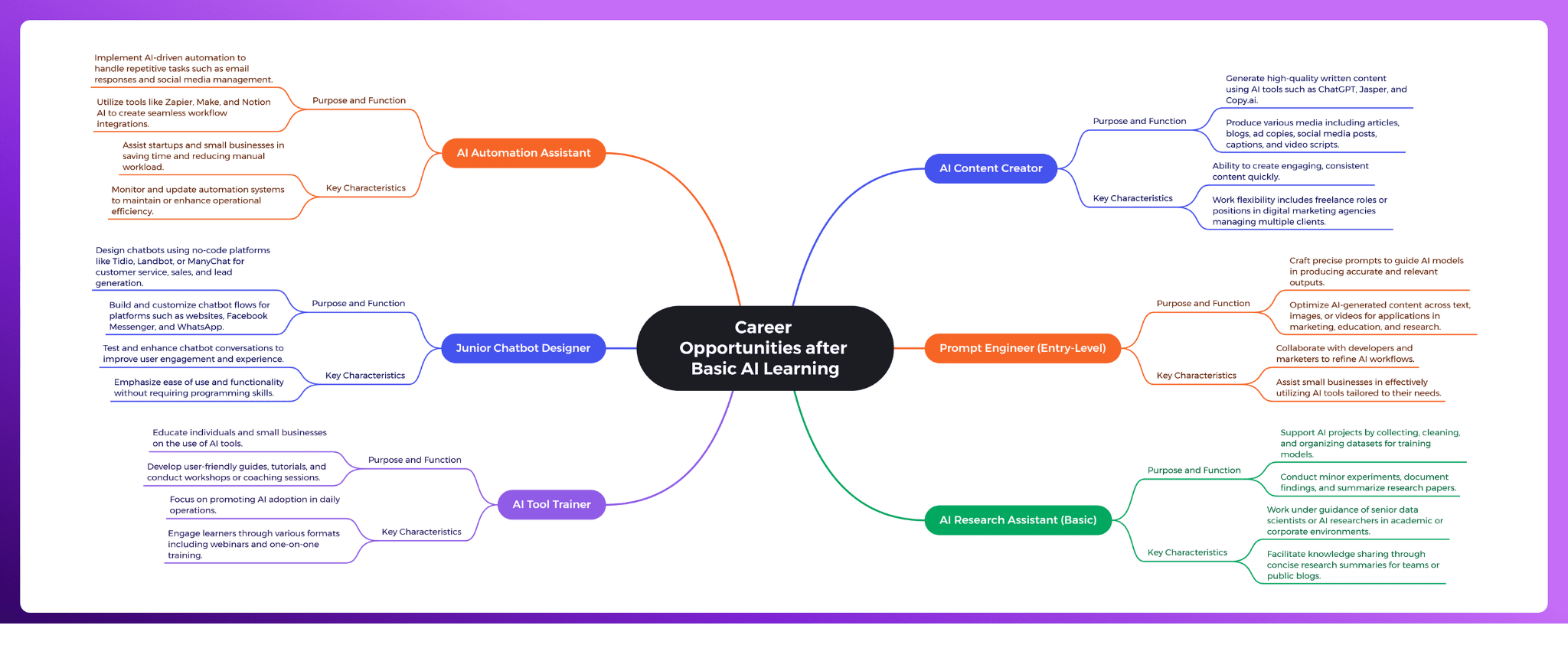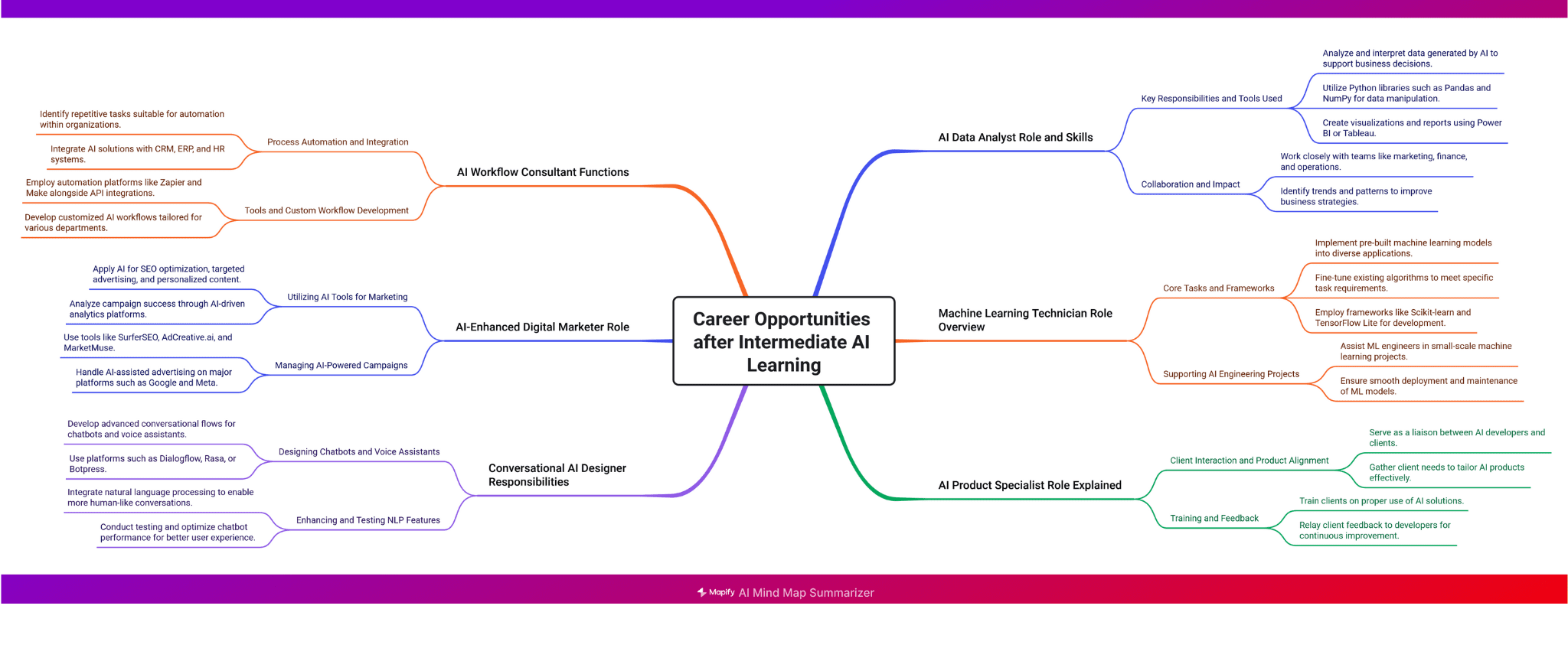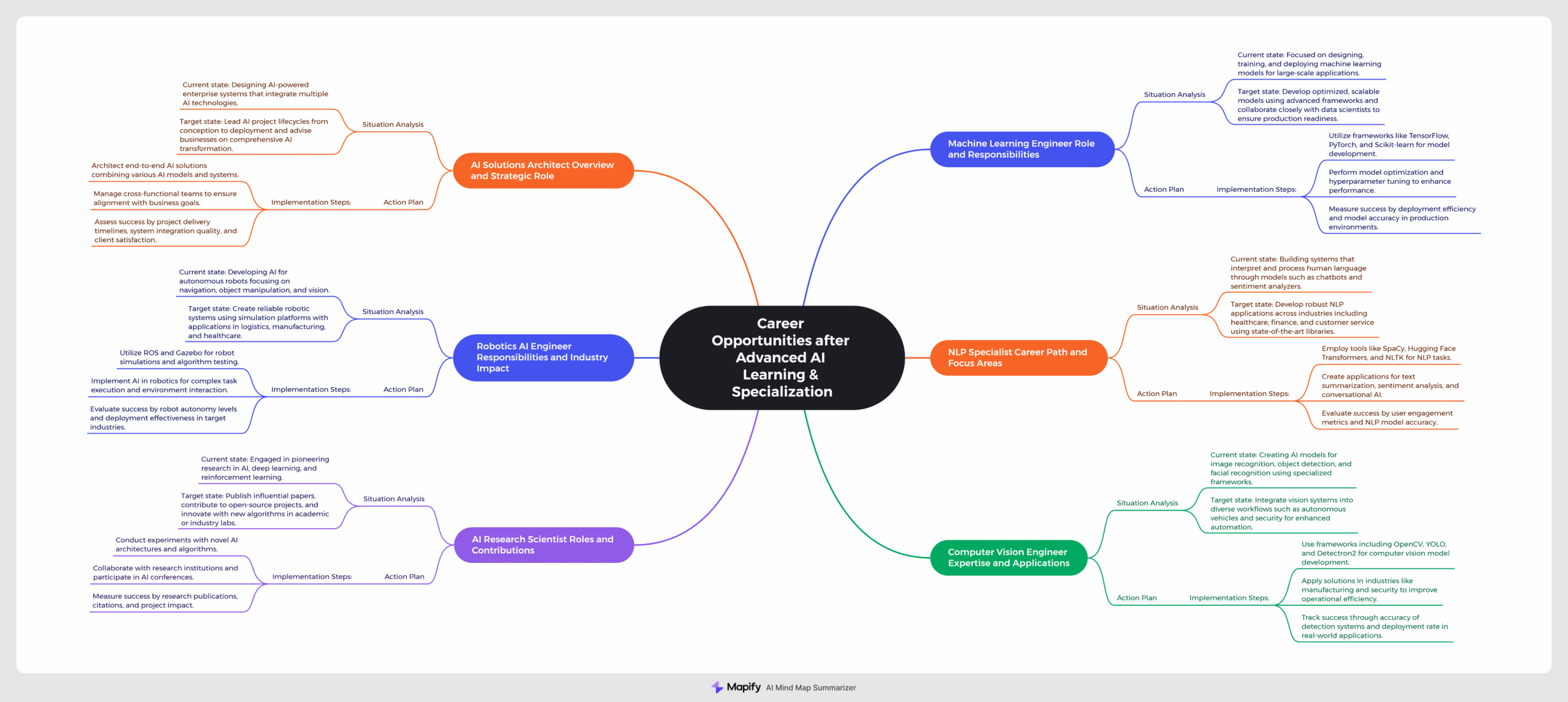Fundamentals of AI
Basic Level – AI Career Roadmap
1. AI Automation Assistant
Purpose and Function:
Implement AI-driven automation to handle repetitive tasks like email responses and social media management.
Use tools like Zapier, Make, and Notion AI for seamless workflow integration.
Help startups and small businesses save time and reduce manual workload.
Key Characteristics:
Monitor and update automation systems.
Maintain and enhance operational efficiency.
2. Junior Chatbot Designer
Purpose and Function:
Design chatbots using no-code platforms like Tidio, Landbot, or ManyChat.
Build and customize chatbot flows for websites, Facebook Messenger, and WhatsApp.
Test chatbot conversations to improve user engagement and experience.
Key Characteristics:
Focus on ease of use and functionality.
No programming skills required.
3. AI Content Creator
Purpose and Function:
Generate high-quality written content using AI tools such as ChatGPT, Jasper, and Copy.ai.
Produce different media formats: articles, blogs, social media posts, captions, and video scripts.
Key Characteristics:
Ability to create engaging and consistent content quickly.
Flexible work opportunities: freelancing or agency roles handling multiple clients.
3. AI Content Creator
Purpose and Function:
Generate high-quality written content using AI tools such as ChatGPT, Jasper, and Copy.ai.
Produce different media formats: articles, blogs, social media posts, captions, and video scripts.
Key Characteristics:
Ability to create engaging and consistent content quickly.
Flexible work opportunities: freelancing or agency roles handling multiple clients.
4. Prompt Engineer (Entry-Level)
Purpose and Function:
Craft precise prompts to guide AI models in generating accurate outputs.
Optimize AI-generated text, images, or videos for marketing, education, and research.
Key Characteristics:
Collaborate with developers and marketers to refine AI workflows.
Help small businesses effectively use AI tools tailored to their needs.
5. AI Tool Trainer
Purpose and Function:
Educate individuals and small businesses on how to use AI tools.
Create user-friendly guides, tutorials, and conduct workshops or training sessions.
Key Characteristics:
Focus on promoting AI adoption in daily operations.
Engage learners via webinars, courses, or one-on-one training.
6. AI Research Assistant (Basic)
Purpose and Function:
Support AI projects by collecting, cleaning, and organizing datasets.
Conduct minor experiments, document findings, and summarize research.
Key Characteristics:
Work under data scientists or AI researchers in academic or corporate environments.
Share knowledge through concise research summaries, reports, or public blogs.
Intermediate Level – AI Career Roadmap
1. AI Workflow Consultant
Functions:
Identify repetitive tasks suitable for automation within organizations.
Integrate AI solutions with CRM, ERP, and HR systems.
Employ automation platforms like Zapier and Make alongside API integrations.
Develop customized AI workflows tailored for different departments.
2. AI-Enhanced Digital Marketer
Role:
Apply AI for SEO optimization, targeted advertising, and personalized content.
Analyze campaign success using AI-driven analytics platforms.
Use tools like SurferSEO, AdCreative.ai, and MarketMuse.
Manage AI-assisted advertising on platforms such as Google and Meta.
3. Conversational AI Designer
Responsibilities:
Develop advanced conversational flows for chatbots and voice assistants.
Use platforms like Dialogflow, Rasa, or Botpress.
Integrate natural language processing (NLP) to enable more human-like conversations.
Conduct testing and optimize chatbot performance for better user experience.
4. AI Data Analyst
Role and Skills:
Analyze and interpret AI-generated data to support business decisions.
Use Python libraries such as Pandas and NumPy for data manipulation.
Create visualizations and reports using Power BI or Tableau.
Work closely with marketing, finance, and operations teams.
Identify trends and patterns to improve business strategies.
5. Machine Learning Technician
Overview:
Implement pre-built machine learning models into diverse applications.
Fine-tune existing algorithms for specific task requirements.
Use frameworks like Scikit-learn and TensorFlow Lite for development.
Supporting AI Engineering Projects:
Assist ML engineers in small-scale machine learning projects.
Ensure smooth deployment and maintenance of ML models.
6. AI Product Specialist
Role Explained:
Act as a bridge between AI developers and clients.
Collect client needs and tailor AI products accordingly.
Train clients on the proper use of AI solutions.
Provide client feedback to developers for continuous improvement.
Advanced Level – AI Career Roadmap (Specialization)
1. AI Solutions Architect Overview and Strategic Role
Situation Analysis:
Design AI-powered enterprise systems integrating multiple AI technologies.
Align AI project lifecycles with business goals.
Implementation Steps:
Architect end-to-end AI solutions combining ML models, data pipelines, cloud services.
Manage cross-functional teams.
Assess project delivery, client satisfaction, and integration quality.
Action Plan:
Ensure alignment with business strategies.
Deliver scalable and effective AI solutions.
2. Robotics AI Engineer Responsibilities and Industry Impact
Situation Analysis:
Develop AI for autonomous robotics (navigation, object manipulation, vision).
Target industries: logistics, manufacturing, healthcare.
Implementation Steps:
Use ROS and Gazebo for simulations & algorithm testing.
Implement AI in robotics for complex tasks and human-robot interaction.
Evaluate success by robot autonomy levels & task effectiveness.
Action Plan:
Push robotics AI into real-world industrial use.
3. AI Research Scientist Roles and Contributions
Situation Analysis:
Focus on pioneering AI research: deep learning, reinforcement learning.
Publish impactful papers, propose novel methods.
Implementation Steps:
Conduct experiments with new AI architectures and algorithms.
Collaborate with global research institutions.
Measure impact via citations & published results.
Action Plan:
Drive AI innovation in academia & industry.
4. Machine Learning Engineer Role and Responsibilities
Situation Analysis:
Design, train, and deploy ML models for real-world scalability.
Develop optimized, production-ready solutions.
Implementation Steps:
Use frameworks: TensorFlow, PyTorch, Scikit-learn.
Optimize performance, reduce computation costs.
Collaborate with DevOps for deployment.
Action Plan:
Measure success by deployment efficiency & production readiness.
5. NLP Specialist Career Path and Focus Areas
Situation Analysis:
Build NLP systems: chatbots, virtual assistants, sentiment analysis.
Target: healthcare, finance, customer service.
Implementation Steps:
Tools: SpaCy, HuggingFace Transformers, NLTK.
Handle NLP tasks: text classification, sentiment analysis, Q&A.
Evaluate success: user engagement, accuracy, model performance.
Action Plan:
Create highly accurate NLP systems for multiple industries.
6. Computer Vision Engineer Expertise and Applications
Situation Analysis:
Build AI for image recognition, object detection, facial recognition.
Apply vision AI for automation, healthcare, and security.
Implementation Steps:
Tools: OpenCV, YOLO, TensorFlow for CV model deployment.
Apply AI vision for industry automation & efficiency.
Track accuracy, detection speed, & deployment readiness.
Action Plan:
Deliver computer vision systems for real-world industrial adoption.




